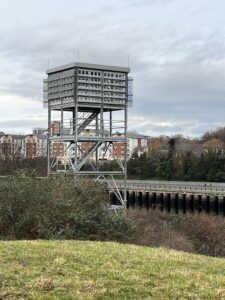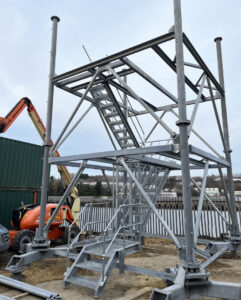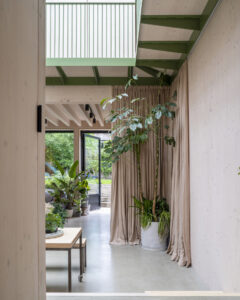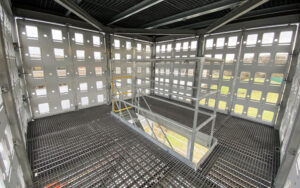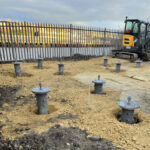New offshore windfarms are now legally required to compensate for any impact their turbines may have on seabird populations. So nesting structures for kittiwakes, that help the birds increase their fledging success rates, are being built around our coast. ‘Kittiwakery’ was installed on the River Tyne, Gateshead in February 2023, as part of the £GW Dogger Bank South offshore wind project.
FLI Structures in partnership with ecologists from Shoney Wind Ltd and kittiwake study programmes, have developed a flexible and modular galvanized steel design that delivers better performance than existing sites. Building these kittiwake nesting structures is in itself, not enough. They must work. Then, for the windfarms to retain their consent to output power, they must carry on working. Unfortunately, previously limited understanding of the bird’s needs and the microclimates around their nests; coupled with the inflexibility of these building’s designs meant that until now, they have typically failed.
The modular and adaptable nature of an open, bolted, galvanized steel structure, delivers the ability to refine or radically alter the tower to ensure both the initial and ongoing performance needed to fulfil the planning consent requirements of the offshore windfarms. The use of galvanized steel screw piles and a bolted, galvanized steel structure, means that when required, entire towers can be disassembled, unscrewed from the ground and moved to new sites.
The tower’s flexibility allows for ongoing adjustments, ensuring optimal breeding success and addressing changes in environmental conditions. By enabling alterations to the layout of nest ledges, addition of nesting cabins, and even the relocation of an entire tower, the structure remains responsive to evolving requirements. This adaptability is pivotal in securing wind farm planning consent, allowing the structures to endure and perform over the long term.
Critical to the success of the ‘Kittiwakery’ is its ability to maintain an ideal nest microclimate, countering challenges posed by solar heat and windrelated cold stress intensified by climate change. The design’s focus on meeting the specific needs of kittiwakes. Galvanized steel is central to the tower’s success, not just for its practical and economic advantages but by enabling the key features that deliver the tower’s sustainability credentials:
- The modular and adaptable nature of an open, bolted structure to ensure both the initial and ongoing performance needed to fulfil the planning consent requirements of the offshore windfarms.
- Galvanized steel screw pile and grillage foundations are 100% reusable and recyclable. Limited excavation, no soil cart away and lighter plant required.
- Galvanizing delivers a major advantage over painted surfaces in these situations, with no joints stuck together or bolts full of paint.
- The kittiwake tower unlocks offshore wind consent impediments to help increase the share of renewable energy in the global energy mix and improve affordability.
Unlike previous structures hindered by limited understanding of avian requirements and inflexible designs, ‘Kittiwakery’ ensures sustained functionality amid changing landscapes. Instead, they stand as resilient and enduring contributors to the delicate balance between sustainable energy production and environmental conservation.
[Content provided by FLI Structures]
Photos © FLI Structures
Architect:FLI Structures
Image:FLI Structures


